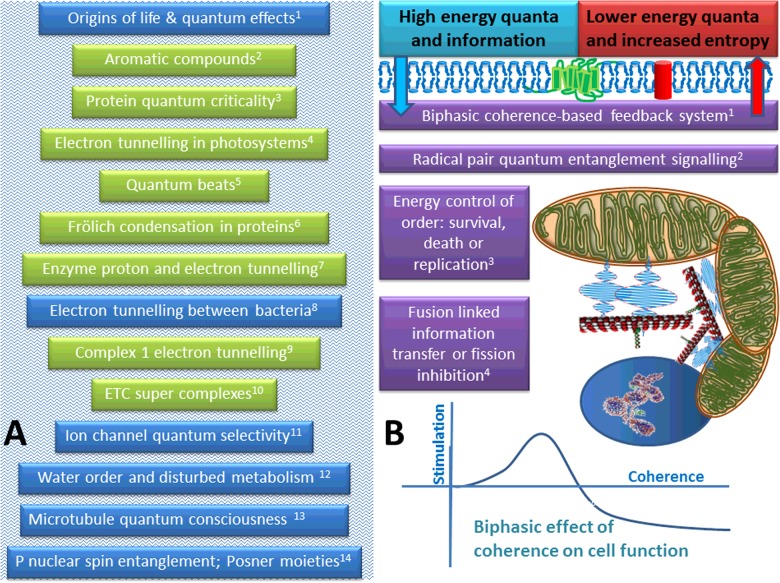Figure 1. The quantum mitochondrion.
This figure summarizes some quantum effects in biology: the green boxes represent those that appear to be established, the blue boxes those that have been suggested to be involved and the purple boxes some we believe might be involved. As living systems takes in energy in order to store and utilize information, so effectively using free energy to do work to create a highly ordered state that becomes more efficient and selectable by natural selection, it exports disorder, so maintaining the second law of thermodynamics. Panel (A) Proven and predicted quantum effects in biology from the literature: (1) life evolved because of, and has incorporated basic quantum principles, such as entanglement and tunnelling [40,74]; (2) aromatic compounds, such as tryptophan, have pi electrons that can delocalize, and can enable quantum effects [75]; (3) the first real evidence for quantum effects has come from the reliance of photosynthesis on electron tunnelling [41,42]; (4) natural selection appears to have resulted in macromolecules tuned for quantum effects suggesting universal mechanisms of charge transport in living matter [52,57]; (5) quantum beating has been detected in living systems, in particular, in photosystems, suggesting life is using quantum effects [41,43,46]; (6) over 40 years ago Fröhlich predicted that vibrational modes within proteins could condense leading to macroscopic coherence, this appears to have now been observed [55]; (7) tunnelling is now thought to be essential in both enzyme reactions and energy transfer, a quintessential component of the quantum world [47–51,64,76]; (8) bacteria live in colonies, often sharing electrons with different species, and it seems that electrons are ‘transported’ over long distances–it would be surprising if tunnelling was not involved, and this sharing between archaea and bacteria is suggestive of this process being adopted in eukaryotes [47,77–79]; (9) several groups now think that electron tunnelling is important in the ETC [48–50]; (10) an important component of electron tunnelling is the existence of super-complexes–these now appear to exist in all orders of life, and are key in both photosynthesis and respiration [80–82]; (11) ion channels play a key role in the brain, and it has been suggested that ion conduction could be described using quantum principles [65,66]; (12) alterations in electric fields surrounding the mitochondrion could play a significant role in changing ‘water order’ and be associated with disease states [56,83,84]; (13) long discussed theory that microtubules could be involved in resonant energy transfer and consciousness due to their quantum properties [45,75]; (14) the nuclear spin properties of phosphorous utilized by transfer of quantum entangled pairs across the synapse in Posner molecules, so effectively acting as a ‘qubit’ [85]. Panel (B) Some predictions of our own: (1) coherence could be controlled by mitochondrial potential, which is turn could enhance quantum tunnelling of electrons (as well, as possibly, other coherence-dependent functions, such as enzyme function or ion channel status)–it could be biphasic as it could enhance efficiency (high ATP, low ROS), but if too high, it could start to hinder ATP by producing too much ROS. Thermodynamically it could initially aid in survival of the individual cell, then favour replication, and if necessary, induce cell death–thus would be hormetic; (2) it is now thought that a radical pair mechanism could be involved in avian navigation (effectively unpaired quantum entangled electron) [53], which might suggest that if such entities were produced in the ETC, it could act as a signal–implying there is more to ROS than thought; (3) if we combine (2) and (3), then any shift in electron flow and/or proton flow, either via electron input, or use, in particular, availability of oxygen, or even cell shape, or damage, would rapidly generate a signal that could instantaneously control mitochondrial function; (4) the effect of mitochondrial dynamics would thus have to viewed in a new light, as it is possible that fusion could enhance a quantum-based signalling system throughout the entire cell, which would be altered by fission.

